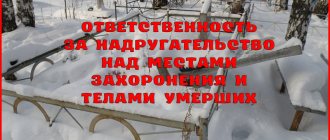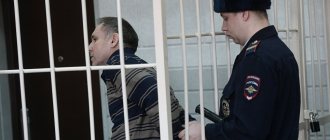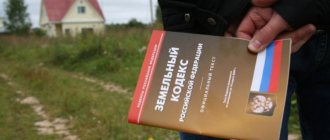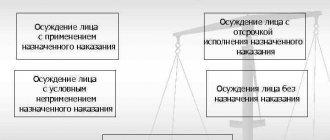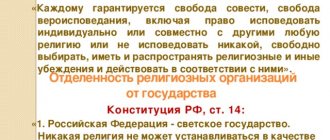ST 244 of the Criminal Code of the Russian Federation.
1. Desecration of the bodies of the dead or destruction, damage or desecration of burial places, gravestones or cemetery buildings intended for ceremonies in connection with the burial of the dead or their commemoration, with the exception of cases provided for in Article 243.4 of this Code, -
shall be punishable by a fine in the amount of up to forty thousand rubles, or in the amount of the wages or other income of the convicted person for a period of up to three months, or by compulsory labor for a term of up to three hundred sixty hours, or by corrective labor for a term of up to one year, or by arrest for a term of up to three months.
2. The same acts committed:
a) by a group of persons, a group of persons by prior conspiracy or an organized group;
b) for reasons of political, ideological, racial, national or religious hatred or enmity, or for reasons of hatred or enmity towards any social group;
c) with the use of violence or the threat of its use, -
shall be punishable by restriction of freedom for a term of up to three years, or forced labor for a term of up to five years, or arrest for a term of three to six months, or imprisonment for a term of up to five years.
The concept and types of desecration of the bodies of the dead and burial places
Violation of the bodies of the dead means active actions consisting of:
- mockery of the remains of the deceased before burial;
- removing a buried person from the grave and causing mechanical damage to the remains, dismembering the body, and committing other cynical actions against it.
Desecration of burial sites consists of deliberate damage and destruction:
- graves;
- cemetery tombstones;
- places where rituals for burial and remembrance of the dead take place.
The elements of the crime, as well as responsibility for it, are specified in Article 244 of the Criminal Code of the Russian Federation.
Another comment on Art. 244 of the Criminal Code of the Russian Federation
1. The subject of the crime is: a) the bodies of the dead; b) burial places (graves, including mass graves, crypts, columbariums); c) grave structures (monuments, crosses, tombstones, grave fences); d) cemetery buildings intended for ceremonies in connection with the burial of the dead or their commemoration (churches, chapels, ritual halls of crematoriums).
2. The objective side of the crime is characterized by the commission of one of the actions specified in the law.
At the same time, in particular, desecration of the bodies of the dead is the commission of immoral, desecrating or cynical actions that violate customs, traditions and the established procedure for burying the dead (pulling the body out of the grave, causing any damage to the body of the deceased, stealing clothes, valuable jewelry, dental crowns).
Desecration means applying inscriptions, drawings, symbols to specified objects, placing garbage on a grave, destroying or damaging flowers, wreaths, etc.
3. The sign of the use of violence or the threat of its use (clause “c” of Part 2) covers the infliction of slight harm to the health of the victim (beating, tying up) and a threat of any kind.
Qualifying characteristics and measures of responsibility
A crime classified under Part 1 of Article 224 of the Criminal Code of the Russian Federation is a crime of minor gravity.
The following penalties are provided:
- Fine up to 40 thousand rubles. The amount of the fine may also be three months' income of the convicted person.
- Another type of punishment is compulsory work lasting up to 360 hours.
- Punishment in the form of correctional labor for up to 1 year or arrest for up to 3 months is also provided.
The crime has a number of qualifying characteristics. Responsibility for a qualified crime is higher. Punishment under Part 2 of Article 244 of the Criminal Code of the Russian Federation is assigned :
- in the form of restriction of freedom for up to 3 years;
- or in the form of forced labor for up to 5 years;
- or in the form of arrest from 3 to 6 months.
In addition, Part 2 of Article 244 of the Criminal Code of the Russian Federation provides for imprisonment for up to 5 years. Thus, the crime moves into the category of medium severity.
In paragraph “a” of part 2 the following qualifying characteristics are indicated::
- Committing a crime by a group of persons .
To qualify on this basis, there is no need to establish the preliminary nature of the agreement. It is enough to prove that not one person, but two or more, took part in the commission of the act, even if their actions were spontaneous. The legislator identified a group of persons as a separate qualifying feature, since damage from the actions of several people is always more significant. In addition, by performing joint actions, individuals are imbued with a common idea and feel support from their accomplices. - By a group of persons by prior conspiracy . To qualify a crime on this basis, it is necessary to establish an agreement between two or more participants to commit illegal actions. Conspiracy must precede the start of active actions. The severity of the crime increases because the act is preceded by planning and preparation of the crime.
- An organized group . The most serious of the qualifying criteria included in paragraph “a” of part 2 of this article. The crime in this case was committed not just by conspiracy, but by a stable group of people who deliberately united to commit crimes. As a rule, there is a distribution of roles within the group and careful planning of illegal acts.
Clause “b” of Part 2 of this article contains additional qualifying characteristics . These include committing actions motivated by political, ideological, racial, national or religious hatred or enmity, or motivated by hatred or enmity in relation to any social group, as well as in relation to:
- sculptural, architectural structure dedicated to the fight against fascism or victims of fascism;
- burial places of participants in the fight against fascism.
The legislator provides for more severe punishment for committing a crime for these reasons, because enmity and hatred in a multinational state may have the nature of a social problem. Stirring up political infighting:
- creates a situation of tension;
- shakes the existing foundations of society;
- may result in a violation of stability and public order.
A criminal who commits an act for these reasons is motivated by a feeling of hostility, antipathy, hatred towards representatives of others:
- nationalities;
- political beliefs;
- religious denominations.
Other reasons may include a sense of superiority or self-affirmation.
Persons who committed desecration of the graves of fighters against fascism are also subject to criminal liability under this paragraph. In addition, this clause includes actions to desecrate or damage sculptures, monuments, and architectural objects related to the fight against fascism.
It does not matter whether these objects are located in burial places of soldiers and civilians or whether they are a separate monument.
, as well as the threat of its use, as a qualifying feature In the event of a beating or minor injury to the victim, no additional qualifications are required. If moderate or serious harm to health is caused, the act is subject to additional qualification under the relevant articles of the Criminal Code of the Russian Federation.
Composition of the crime and criminal legal characteristics
- The direct object of the crime , that is, those social relations that the criminal encroaches on, are moral principles and customs for burying the bodies of the deceased. The criminal encroaches on national traditions in the field of burial, on the blessed memory and honor of people resting in burial places.
- The optional object , that is, what the criminal attempts indirectly, during the commission of the act, is the property of the relatives of the deceased, their intangible benefits.
The objective side consists of a number of actions. These include:
- Abuse of the remains of the deceased, which can be expressed in removal from the grave, dismemberment and other damage to the corpse, removal and theft of clothing and valuables, illegal burial in another place, and other cynical actions.
- Destruction of burial sites, structures and buildings on the territory of the cemetery in which memorial ceremonies are held. Actions that led to the destruction of the specified places or to their significant damage, in which their intended use becomes impossible.
- Damage to the specified objects, causing such damage as a result of which restoration and restoration are required.
- Desecration of objects by applying immoral inscriptions, images on them, leaving garbage and sewage in the indicated places with the aim of desecrating the burial site.
This crime has a material and formal composition. It is considered completed from the moment the consequences occur in the event of destruction or damage to the burial site.
In the case of committing actions to desecrate a burial place and desecrate the body of the deceased, the onset of socially dangerous consequences is not required, the crime is considered completed at the moment of commission of these actions.
The subject is a sane person who has reached the age of 16 . The legislator considered that full awareness of the illegality of one’s actions, their immorality and cynicism occurs by the specified age.
Younger adolescents may be driven by a desire for self-affirmation, imitation of elders, and other motives that are not directly related to the desire to damage morality and public interests.
The subjective side is characterized by direct intent . The criminal is aware of the social danger of his actions and desires the consequences.
If the harm was caused as a result of careless actions, there will be no crime. For example, if a driver, turning the car around near a burial site, inadvertently damages a tombstone, his actions will not be qualified under Article 244 of the Criminal Code of the Russian Federation due to the lack of direct intent.
General provisions
Each culture has its own burial traditions. The dead are treated with respect, trying to pay final respects to the deceased person.
Any illegal actions committed with the body of the deceased are punishable under Article 244 of the Criminal Code of the Russian Federation. This normative act provides for liability for abuse of the dead, desecration of graves, and acts of vandalism against religious buildings.
The attacker will receive punishment for the following illegal actions:
- any unnatural manipulations with the body of the deceased;
- abuses contrary to moral and religious principles;
- removing a corpse from the grave;
- desecration and destruction of graves, including drawings and symbols;
- desecration of places where post-mortem ceremonies are held.
By committing the above actions, the criminal acts intentionally. He realizes the size of the resulting damage. Desecration of the deceased or the place of his burial cannot be committed through negligence. Therefore, the attacker will be able to avoid punishment only if he is insane and is not aware of his own actions.
An attacker who has reached the age of 16 and does not have mental disabilities can receive punishment under Article 244 of the Criminal Code of the Russian Federation.
Distinction between related offenses
To correctly qualify unlawful acts, it is necessary to distinguish between related crimes.
Vandalism - Article 214 of the Criminal Code of the Russian Federation
The crime provided for in Article 244 of the Criminal Code of the Russian Federation differs from the crime provided for in Article 214 of the Criminal Code of the Russian Federation for the object of the criminal attack.
- The object of vandalism is public safety and the normal functioning of society. A criminal, by committing acts of damage to property, infringes on the interests of people using this property. The subject of encroachments are structures, buildings, structures, transport facilities intended for public use.
- The object of desecration of bodies and desecration of graves is public morality, the memory of the deceased, their good name, and burial traditions. The objects of criminal assault in this case are the bodies of the deceased, tombstones and monuments, objects used to commemorate the dead.
Hooliganism - Article 213 of the Criminal Code of the Russian Federation
The object of hooliganism under Article 213 of the Criminal Code of the Russian Federation is public order. A hooligan disturbs the peace of citizens, wants to disturb the peace of citizens, and causes outrage with his actions.
Actions under Article 244 of the Criminal Code of the Russian Federation are directed against public morality and morality, affecting the following issues:
- burials of the deceased;
- preserving the memory of them;
- keeping the remains intact.
Vandalism at the cemetery
Responsibility for any manifestations of vandalism comes under Article 214 of the Criminal Code of the Russian Federation. However, actions to desecrate graves are considered under Article 244 of the Criminal Code of the Russian Federation. We are talking about damage or destruction of the following objects:
- gravestones, monuments in places of single burials in rural and urban cemeteries;
- tombstones of mass graves, monuments to fallen soldiers.
The latter are of cultural and historical value. Therefore, the punishment for the destruction of monuments may be increased by a court decision.
Vandalism can involve two types of criminal acts:
- Complete or partial destruction of an object. As a result of such actions, restoration of the monument/tombstone or its replacement is required.
- Abuse, as a result of which the integrity of the object was not violated. We are talking about inscriptions and drawings.
